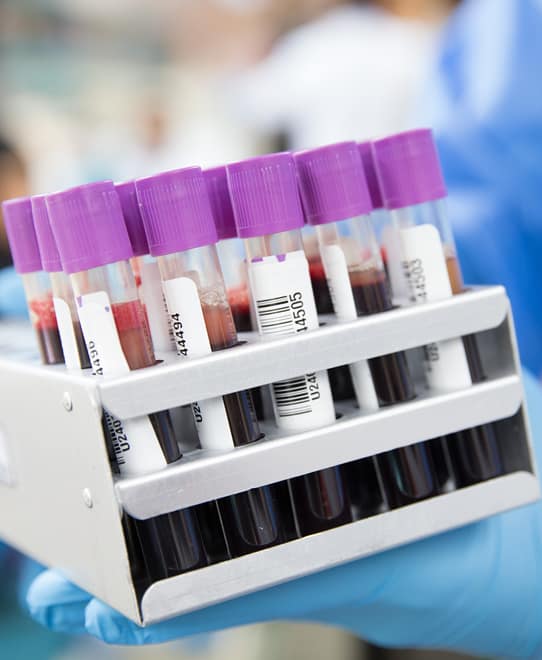Breast Cancer is the most frequently diagnosed cancer in women, with almost 2.3 million new cases diagnosed globally in 2022 and 8.2 million women living with the disease.
Despite new treatment options and advances in patient management protocols, research shows that between 15% and 30% of women initially diagnosed with earlier stages of breast cancer are at risk of developing recurrent advanced or metastatic disease. Although the prognosis of patients with metastatic breast cancer (MBC) has significantly improved, the 5-year survival rate for breast cancer patients with metastases is just 31%. Advancements in biopsy methodology for MBC are needed to improve patient monitoring and survival.
The UK National Health Service (NHS) follows the National Institute of Health (NICE) guidelines which recommends a core or needle biopsy along with physical examination and imaging (mammogram, ultrasound) to diagnose breast cancer. The most recent ESMO clinical practice guidelines for diagnosis, staging and treatment of MBC patients also recommend that patients with newly diagnosed or recurrent MBC should undergo a tissue biopsy. Solid tissue biopsy confirms malignancy and tumour tissue receptor status which is clinically relevant to determine breast cancer subtype, clinical prognosis, and the choice of targeted therapy. However solid tissue biopsy is invasive, costly, time-consuming, potentially harmful, and is unsuitable for longitudinal monitoring. Tumour tissue may also be inaccessible or report a false negative if an insufficient sample is taken.
Key statistics
1st
most frequently diagnosed cancer in women
2.3 million
new cases diagnosed globally in 2022
8.2 million
women living with breast cancer in 2022
31%
5-year survival rate for late those patients where breast cancer has metastasised*
15-30%
of women diagnosed with earlier stages will develop recurrent advance or metastatic disease
Circulating Tumour Cells (CTCs) obtained via liquid biopsies have significant potential for clinical decision making alongside current standard of care.
This includes diagnosis and accurate prognosis, therapeutic target selection, monitoring treatment response and resistance, spatiotemporal monitoring of metastasis, and disease relapse. Access to tumour cells from a peripheral blood sample can provide non-invasive, real-time monitoring of cancer patients and insight into clonal evolution during tumour metastasis and treatment.
In May 2022 the US FDA granted ground-breaking product clearance (De Novo Class II) for the Parsortix® PC1 System to harvest CTCs from MBC patient blood for subsequent, user-validated analysis. See: Intended Use
This submission included data in 421 participants (216 patients with metastatic breast cancer and 205 female healthy volunteers) from a multicentre study across four US cancer centres published in the journal Cancers in October 2022.

In my team’s research, we have demonstrated how circulating tumour cells harvested by this system are a good surrogate for tissue biopsies of the metastatic site. With this regulatory clearance we can now obtain repeat biopsies periodically to provide up-to-date information to guide treatment decisions, improving care and minimizing invasive procedures for these patients.”
Julie E. Lang, MD, FACS
Director, USC Breast Cancer Program, Associate Professor of Surgery, Norris Comprehensive Cancer Center, University of Southern California
In addition to ANGLE sponsored studies there are currently 38 peer-reviewed publications in breast cancer patients from 17 independent study centres in nine countries. Highlights from this research includes:
Collectively these studies have utilised a wide range of downstream analysis methods including DNA and RNA sequencing, PCR, and immunofluorescence to analyse a range of clinically actionable biomarkers such as EGFR, PIK3CA, HER2, ER, PR, and PD-L1.
Resources related to breast cancer

Posters
Custom Gene Expression Profiling of Circulating Tumor Cells via Amplitude-Based Multiplex digital PCR
ANGLE Europe Limited, Guildford, UK, published at ACTC Meeting 2025
Publications
June, 2025
Phylogenetic inference reveals clonal heterogeneity in circulating tumour cell clusters
Product Intended use:
The Parsortix®PC1 system is an in vitro diagnostic device intended to enrich circulating tumour cells (CTCs) from peripheral blood collected in K2EDTA tubes from patients diagnosed with metastatic breast cancer. The system employs a microfluidic chamber (a Parsortix cell separation cassette) to capture cells of a certain size and deformability from the population of cells present in blood. The cells retained in the cassette are harvested by the Parsortix PC1 system for use in subsequent downstream assays. The end user is responsible for the validation of any downstream assay. The standalone device, as indicated, does not identify, enumerate or characterise CTCs and cannot be used to make any diagnostic/prognostic claims for CTCs, including monitoring indications or as an aid in any disease management and/or treatment decisions.
*Based on US data
